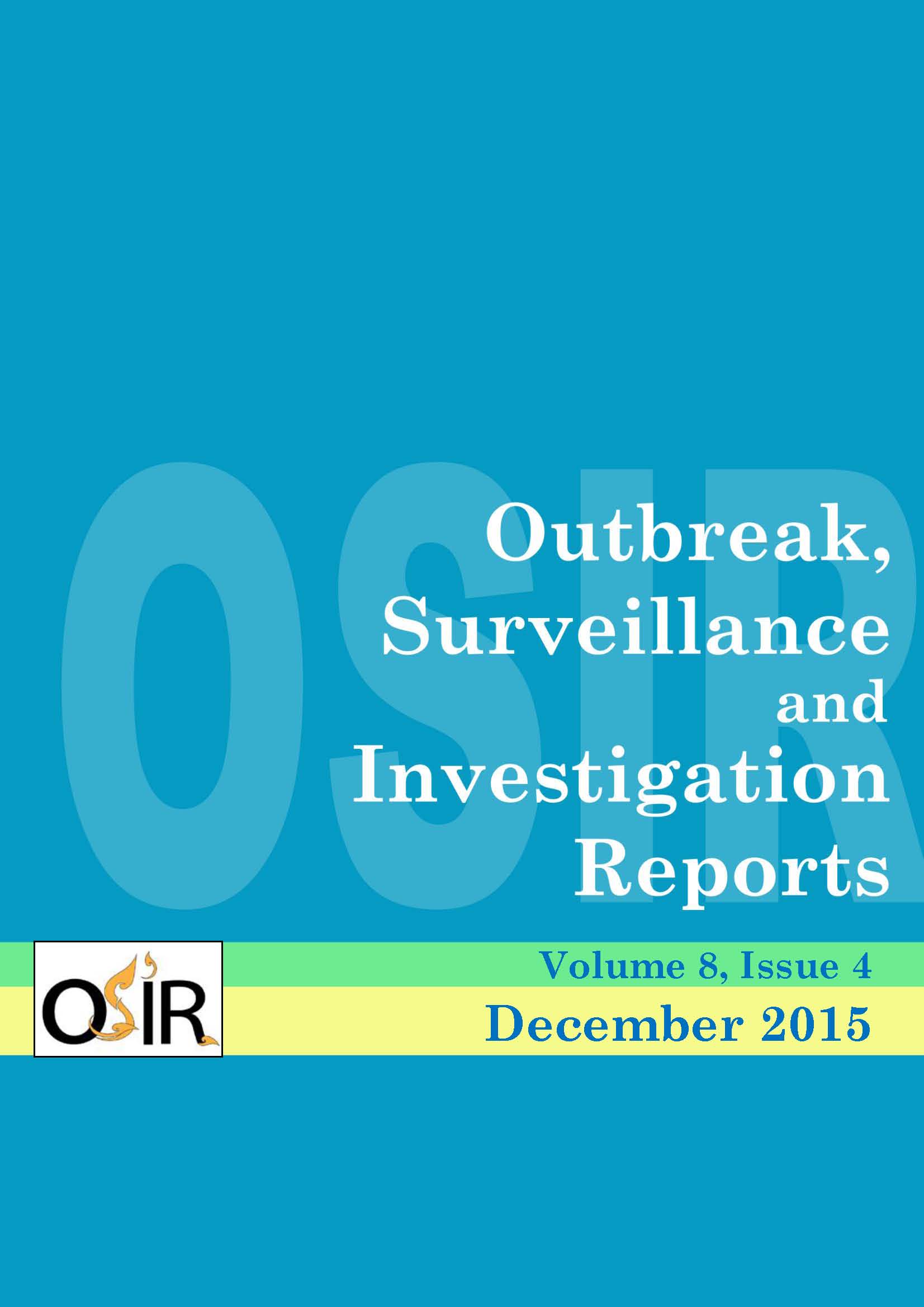Assessment on Exposure to Highly Pathogenic Avian Influenza A(H5N1) and Poultry Trading Practices among Poultry Traders in Traditional Markets of Sukoharjo District, Central Java Province, Indonesia, 2012
DOI:
https://doi.org/10.59096/osir.v8i4.263231Keywords:
HPAI A(H5N1), antibody titer, poultry tradersAbstract
Sukoharjo District has been an endemic area of highly pathogenic avian influenza (HPAI) subtype A(H5N1). We conducted a serology investigation to determine the level of human exposure to HPAI A(H5N1) and describe trading practices of poultry in eight live bird markets in Sukoharjo. A cross-sectional study was conducted in traditional markets. Total 75 traders were selected using simple random sampling proportionally from 221 traders in all eight markets. Serum samples were tested for H5N1 antibody titer by hemagglutination inhibition test. There was no trader with positive H5N1 antibody. Majority of the traders washed carcasses (84.0%), used containers to carry poultry and carcasses (94.7%), and cleaned places of trading (94.7%). Poultry traders had not been infected by HPAI A(H5N1).
References
Hulse-Post DJ, Sturm-Ramirez KM, Humberd J, Seiler P, Govorkova EA, Krauss S, et al. Role of domestic ducks in the propagation and biological evolution of highly pathogenic H5N1 influenza viruses in Asia. Proc Natl Acad Sci U S A. 2005 Jul 26;102(30):10682-7. Epub 2005 Jul 19.
Food and Agriculture Organization of the United Nations. Biosecurity for higly pathogenic avian influenza: issues and options. Rome: 2. Food and Agriculture Organization of the United Nations; 2008.
Smith GJ, Naipospos TS, Nguyen TD, de Jong MD, Vijaykrishna D, Usman TB, et al. Evolution and adaptation of H5N1 influenza virus in avian and human hosts in Indonesia and Vietnam. Virology. 2006 Jul 5;350(2):258-68. Epub 2006 May 19.
Republic of Indonesia. Ministry of Agriculture. The development situation of AI cases in poultry in Indonesia. Jakarta: Ministry of Agriculture of the Republic of Indonesia; 2012.
World Health Organization. Avian influenza – situation in Indonesia: update. 2012 [cited 2012 Mar 1]. <http://www.who.int/csr/don/2012_03_01/en/index.html>
Sukoharjo District Agricultural Office. Map of animal diseases Sukoharjo 2011. Sukoharjo: Sukoharjo District Agricultural Office; 2012.
Sukoharjo District Health Office. Health profile Sukoharjo 2011. Sukoharjo: Sukoharjo District Health Office; 2012.
Van Kerkhove MD, Mumford E, Mounts AW, Bresee J, Ly S, Bridges CB, et al. Highly pathogenic avian influenza (H5N1): pathways of exposure at the animal-human interface, a systematic review. PLoS One. 2011 Jan 24;6(1):e14582.
Nguyen DC, Uyeki TM, Jadhao S, Maines T, Shaw M, Matsuoka Y, et al. Isolation and characterization of avian influenza viruses, including highly pathogenic H5N1, from poultry in live bird markets in Hanoi, Vietnam, in 2001. J Virol. 2005 Apr;79(7):4201-12.
Lemeshow S, Jr Hosmer DW, Klai J, Lwangsa SK. In a size sample clinical research. Yogyakarta: Gadjah Mada University Press; 1997.
Sastroasmoro S, Ismael S. Basics of clinical research methodology. Jakarta: Publisher CV Sagung Seto; 2008.
Katz JM, Lu X, Frace AM, Morken T, Zaki SR, Tumpey TM. Pathogenesis of and immunity to avian influenza A H5 viruses. Biomed Pharmacother. 2000 May;54(4):178-87.
Wood JM. Developing vaccines against pandemic influenza. Philos Trans R Soc Lond B Biol Sci. 2001 Dec 29;356(1416):1953-60.
Rofiq A, Suwandono A, Rahardjo E, Hendra PR. Serosurvey on influenza among workers, sales and product handlers of chicken in 8 provinces with bird flu outbreak. World Mirror of Medicine. 2005;148:17-20. Indonesian.
Setiawaty V, Sedyaningsih ER, Sudiro TM, van Beest Holle MRDR, Pangesti KNA, Ibrahim F. Antibody anti-H5N1 detection in poultry farmers and workers in poultry collection facilities in Indonesia, 2007. Indones Med J. 2010 May;19(2):124-9.
Werner O, Harder TC. Avian influenza. In: Kamps BS, Hoffmann C, Preiser W, editors. Influenza report 2006. p. 48-73. [cited 2012 Jan 4]. <http://www.influenzareport.com/ir/ai.htm>
Cavailler P, Chu S, Ly S, Garcia JM, Ha do Q, Bergeri I, et al. Seroprevalence of anti-H5 antibody in rural Cambodia, 2007. J Clin Virol. 2010 Jun;48(2):123-6. Epub 2010 Mar 30.
Treanor JJ. Influenza virus. In: Mandell GL, Bennett JE, Dolin R, editors. Mandell, Douglas, and Bennett's principles and practice of infectious diseases. 6th ed. Philadelphia: Elsevier Churchill Livingstone; 2005.
Wang M, Di B, Zhou D, Zheng B, Jing H, Lin Y, et al. Food markets with live birds as sources of avian influenza. Emerg Infect Dis. 2006 Nov;12(11):1773-5.
Widjaja L, Krauss SL, Webby RJ, Xie T, Webster RG. Matrix gene of influenza A viruses isolated from wild aquatic birds: ecology and emergence of influenza A viruses. J Virol. 2004 Aug;78:8771-9.
Couch RB. An overview of serum antibody responses to influenza virus antigens. Dev Biol (Based). 2003;115:25-30.
Rowe T, Abernathy RA, Hu-Primmer J, Thompson WW, Lu X, Lim W, et al. Detection of antibody to avian influenza A (H5N1) virus in human serum by using a combination of serologic assays. J Clin Microbiol. 1999 Apr;37(4):937-43.
Fox JP, Hall CE, Cooney MK, Foy HM. Influenza virus infections in Seattle families, 1975-1979. I. Study design, methods and the occurrence of infections by time and age. Am J Epidemiol. 1982 Aug;116(2):212-27.
Dejpichai R, Laosiritaworn Y, Phuthavathana P, Uyeki TM, O'Reilly M, Yampikulsakul N, et al. Seroprevalence of antibodies to avian influenza virus A (H5N1) among residents of villages with human cases, Thailand, 2005. Emerg Infect Dis. 2009 May;15(5):756-60.
Stevens J, Blixt O, Tumpey TM, Taubenberger JK, Paulson JC, Wilson IA. Structure and receptor specificity of the hemagglutinin from an H5N1 influenza virus. Science. 2006 Apr 21;312(5772):404-10. Epub 2006 Mar 16.
Downloads
Published
How to Cite
Issue
Section
License
Copyright (c) 2023 Outbreak, Surveillance, Investigation & Response (OSIR) Journal

This work is licensed under a Creative Commons Attribution-NonCommercial-NoDerivatives 4.0 International License.









